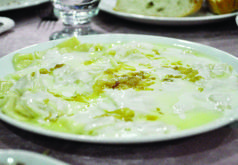Seeing Kars before the summer ends
Tuba Köseoğlu Okçu KARS - Hürriyet Daily News


Kars’ historic heritage is breathtaking, but there are few tourists around: Militant activity by the outlawed Kurdistan Workers’ Party (PKK) in the 1990s hampered all tourism. Recovery to the pre-1985 era when the city hosted two to three groups of tourists per week seems to still be away despite nice hotels.
The traces of 40 years of Russian occupation starting in the 1890s is still visible and means the city’s landscape is different from that of other Anatolian cities: one- or two-story buildings (built so as to enable the sun’s rays to defrost ice on the streets) still dominate urban Kars and they are either used today as government offices or are ruins desperately waiting for restoration.
The inhabitants of Kars are extremely hospitable and smiling and are willing to help, guide and support visitors. Life in the streets is unexpectedly lively, even late at night. Women, unlike many other Anatolian cities, take an active part in urban life.
The Ani Ruins
The main destination for tourists is, of course, the Ani Ruins. Until 20 years ago, visits to this site were subject to special permission from the city’s police department as it’s just on the border to Armenia; fortunately, such bureaucracy is not in place anymore. Though only 15 percent of the site is excavated, the Ani Ruins are still spectacular: layers of civilizations lie in front and below you. This spot is literally “the cradle” of civilizations: on one side you have the Manuçehr Mosque, one of the first mosques built on Anatolian soilİ on the other you have the Fire Temple of Zarathustra; on the right you have Tigran Honents Church, the only church in the world with original drawings about the history of Armenians and on the left, you have the hamams dating back from Seljuk Empire… A few steps behind you have the remnants of a Georgian church, built in a Gothic style – 200 years before the Gothic style was even used…. And on the other side of the river, you have Armenia in its entire splendor. The more you walk around this vast side, the more you realize how silly the limitations, prejudices and categorizations we humans have created are.
A small museum in downtown Kars (called the Kars Museum) is a great location to trace all the civilizations that settled in the area. Both archaeological and ethnographic footprints starting from the paleolithic era to the Urartus, Sasanians, Mongolians and Romans of the area can be found in this small gem. Entrance is free and there is a lovely corner inside for kids. The serene garden is decorated with statues and tombstones bearing the symbols of shamanism yet created by the first Muslims of the region who obviously still carried their shamanistic habits in the early years of their new religion. In the backyard, an important witness of the first days of young the Turkish Republic is exhibited: a railway car bearing Russian and Ottoman scripts. This is in fact the very railway car itself in which the newly founded USSR sent and handed over in Kars 500,000 pieces of gold to support Mustafa Kemal and his friends in their fight for independence in the early 1920s.


Sarıkamış, a lively ski center in winter, is another town where Russian architecture remaining from the occupation years is very dominant. A hunting lodge attributed to Catherine the Great commands the whole town. The building is almost demolished today, but has not fully lost its splendor. Unlike Kars’ downtown, you can barely see women in the streets and the men around don’t seem to like visitors; smiling faces are hard to spot.
Çıldır Lake, around two hours by car, is a magnet for trekking fans. The very few shabby fish restaurants on the shore are full of locals and few tourists. At 2,200 meters above sea level, this place is very cold even on the hottest day of summer. In winter, sledge tours with horses are organized on the frozen lake.
Culinary
Culinary pleasures deserve special attention in Kars: cheese, honey and butter are sine qua non purchases to be made once you are in this city. All organic, very reasonably priced and delicious, these items can also be sent directly to your address both in Turkey and outside Turkey.


What should one taste there? Well, first “kete” a substitute for bread; “ayran aşı” a special soup prepared with local vegetables, “hangel” a pastry prepared with yogurt, onion and butter and as main course, of course goose meat and bulghur. Don’t expect any foie gras in Kars: their liver is too small to prepare pate de foie gras.
Renovated Russian house
“The” place to find entertainment in Kars is KARStore, located in a renovated Russian house. The place also serves dinner (they have a special local dish, resembling goulash but served in mugs!!) but it’s preferred rather for after-dinner drinks. The main entertainment is the performance of troubadours, an ancient and almost dying art in Anatolia.
Of course, the essence of troubadours is in the language and thus, without translation, the satire-based crosstalk between troubadours do not really make sense but still, it’s not to be missed as the next time you come, you might find no troubadours left, as young generations are not keen on to pass on this traditional art.
These experiences are just a flight away: there is a direct flight from Istanbul to Kars and from Kars to Istanbul every day. Before the cold takes hold of the region, go and discover this remote yet exciting city… Don’t forget the old saying: you won’t see Kars unless you hit the road to visit Kars…
